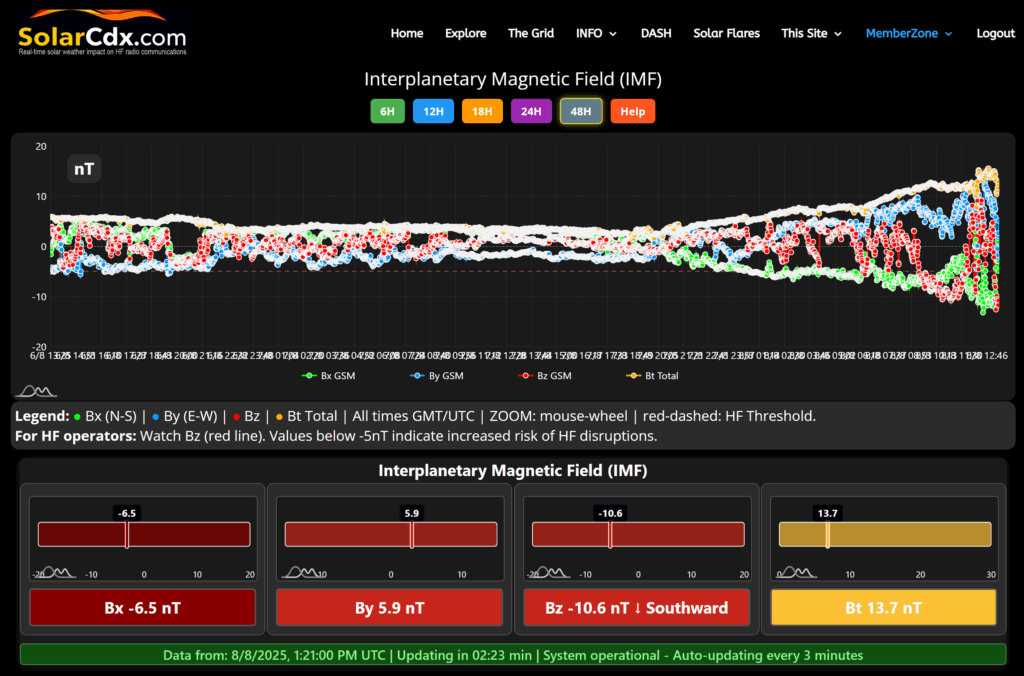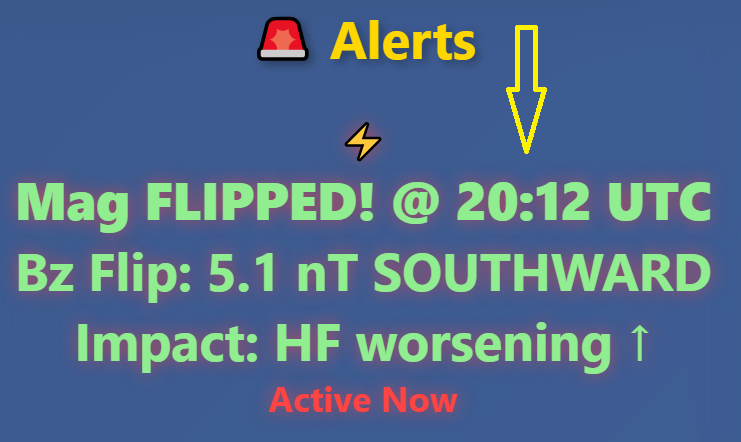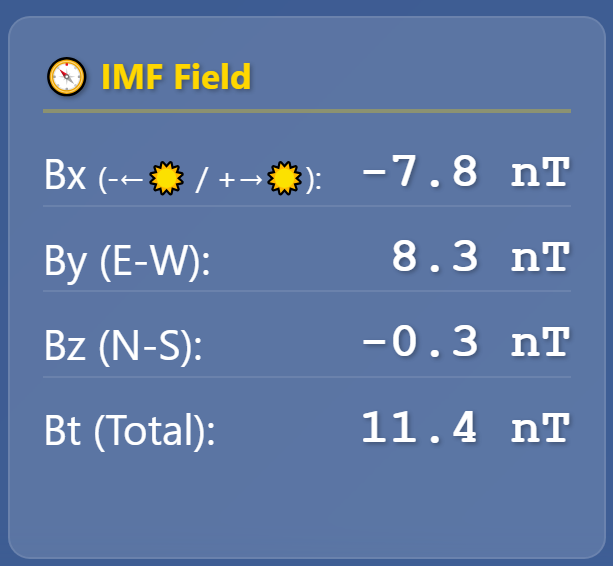Your Real-Time Guide to HF Propagation Success
How SolarCdx.com’s advanced monitoring tools help you master the space weather that controls your HF communications
Tell me quick, the bands are making noise!
The Interplanetary Magnetic Field (IMF) is essentially the Sun’s magnetic field carried through space by the solar wind, and its orientation when it hits Earth determines whether your HF bands will cooperate or completely tank. Think of it as a cosmic switch – when the IMF (Bz) points northward, Earth’s magnetic field acts like a shield, keeping most solar wind energy out and your propagation relatively stable.
But when that Bz flips southward and stays there, it’s like opening the floodgates, allowing solar wind energy to pour into Earth’s magnetosphere and create the geomagnetic storms that mess with the ionosphere.
This is the key mechanism behind those frustrating days when your 20-meter Europeans disappear, your 40-meter signals get absorbed into nothing, and the MUF predictions become about as reliable as weather forecasts – because a sustained southward Bz can trigger hours or days of ionospheric chaos that makes HF propagation unpredictable and often impossible on affected paths.
The difference between knowing this and not knowing it?
SolarCdx.com gives you the real-time tactical intelligence to see it coming and adapt your strategy accordingly.
The Science Behind Your Signal Success
The Interplanetary Magnetic Field’s interaction with Earth’s magnetosphere is the primary driver of space weather effects that impact HF radio communications. When the IMF rotates southward, it enables magnetic reconnection at the magnetopause, allowing solar wind energy to efficiently couple into the magnetospheric system and drive geomagnetic activity.
This coupling process initiates a chain of magnetosphere-ionosphere interactions that directly affect radio wave propagation. The solar wind energy channeled through reconnection accelerates charged particles toward Earth’s polar regions, where they collide with atmospheric constituents in the ionosphere, increasing electron density and creating structured irregularities that fundamentally alter the electromagnetic environment through which HF signals propagate.
SolarCdx.com’s real-time IMF monitoring charts show you exactly when these critical transitions occur, giving you the warning you need to adjust your operating strategy.
How IMF Changes Destroy Your HF Plans (And How to See Them Coming)
Absorption Enhancement
Increased D-region electron density from particle precipitation creates stronger collisional absorption of HF waves. This absorption follows predictable frequency dependencies, with lower frequencies experiencing proportionally greater attenuation. Your 80-meter signals will suffer more severe attenuation than 20-meter signals during the same geomagnetic event.
SolarCdx.com Advantage: Our comparison tools help you understand which bands will be most affected and when to make the switch to higher frequencies.
Ionospheric Irregularities
Enhanced electric fields and particle precipitation create field-aligned irregularities that cause signal scintillation. These irregularities scatter radio waves, producing rapid amplitude and phase fluctuations that degrade communication quality, particularly on trans-auroral and polar paths.
SolarCdx.com Intelligence: Real-time monitoring helps you identify which geographic routes will be affected and which alternative paths remain viable.
Dynamic MUF Variations
Geomagnetic disturbances alter F-region electron density distributions through enhanced electric fields and neutral atmosphere heating. This creates unpredictable changes in the Maximum Usable Frequency, making traditional propagation predictions unreliable during active periods.
SolarCdx.com Tools: System analysis gives you the data to understand how current conditions compare to past events and what to expect in the coming hours.
The Critical Timeline: From Space to Your Shack
The temporal evolution of IMF effects follows a predictable sequence that SolarCdx.com’s monitoring systems track in real-time:
- Solar Wind Transit: 30-60 minutes from L1 monitoring satellites to Earth
- Magnetospheric Response: 15-30 minutes for initial coupling effects
- Storm Development: Main phase develops over 2-6 hours
- Recovery Period: 24-72 hours depending on disturbance magnitude
The Critical Thresholds SolarCdx.com Tracks
While minor southward IMF deflections (Bz around -1 to -3 nT) cause minimal disruption, sustained values below -5 nT indicate high probability of significant HF impacts. Values below -10 nT often correlate with severe geomagnetic storms that can cause widespread HF blackouts.
SolarCdx.com’s threshold alerting system automatically notifies you when these critical values are approached, giving you the tactical advantage of advance warning.
Your Tactical Intelligence Advantage

Look at the chart above. 48Hrs before a solar storm, the IMF field shows its very organized around the 0 axis. As the IMF fields begin to disorganize, you can see the effects immediately on the graph.
Modern space weather monitoring provides real-time IMF data from satellites positioned at the L1 Lagrange point.
But raw data isn’t intelligence – Everyone has raw data, and unless your brain can store the complex metrics and values needed to determine what will and will not affect HF, you need something else to help you.
SolarCdx.com transforms that data into actionable propagation intelligence:
Real-Time Monitoring Tools
- Live IMF Bz tracking with historical context and trend analysis
- Magnetic reconnection indicators showing when conditions favor storm development
- Propagation impact forecasts specific to your operating frequencies and preferred paths
Historical Analysis Capabilities
- Pattern recognition tools that compare current conditions to past events
- Seasonal and solar cycle trending to understand long-term propagation patterns
- Success rate analysis showing which bands and paths work best under specific IMF conditions
Predictive Intelligence
- 45-90 minute advance warnings based on L1 satellite data
- Path-specific impact assessments for your regular operating routes
- Frequency optimization recommendations based on expected absorption and MUF changes
From Data to Decisive Action
Understanding the physical mechanisms behind IMF-driven propagation effects transforms space weather from mysterious “band conditions” into predictable electromagnetic phenomena.
 When SolarCdx.com’s monitoring systems show the IMF rotating southward, you’re seeing the trigger for magnetosphere-ionosphere coupling that will affect your signals within the hour.
When SolarCdx.com’s monitoring systems show the IMF rotating southward, you’re seeing the trigger for magnetosphere-ionosphere coupling that will affect your signals within the hour.
The ionospheric disturbances that disrupt HF communications aren’t random events—they’re the direct result of well-understood electromagnetic processes that SolarCdx.com tracks, analyzes, and presents in operator-friendly formats.
Your Competitive Operating Strategy
- Monitor SolarCdx.com’s IMF dashboard before important contacts or contests
- Set up automated alerts for critical Bz threshold crossings
- Use historical pattern matching to predict storm duration and intensity
- Access real-time absorption maps to select optimal frequencies
- Track recovery progress to know when normal propagation will return
The SolarCdx.com Difference: Intelligence, Not Just Data
The Interplanetary Magnetic Field represents the primary control mechanism for space weather effects on HF communications. While other sites might show you raw numbers, SolarCdx.com provides the analysis, context, and tactical intelligence that transforms that data into operating success.
Our comprehensive monitoring suite includes:
- Real-time IMF orientation tracking with predictive algorithms
- Historical event correlation showing how past similar conditions affected propagation
- Multi-parameter space weather integration combining IMF data with solar activity and geomagnetic indices
- Operator-specific tools designed by hams, for hams
The bottom line: When you understand how IMF orientation drives magnetosphere-ionosphere interactions, and you have SolarCdx.com’s real-time monitoring and analysis tools at your disposal, you gain a significant competitive advantage in predicting and adapting to changing propagation conditions.
Don’t let space weather catch you off guard. SolarCdx.com gives you the intelligence advantage you need to stay ahead of the ionospheric chaos and make the contacts that matter.
Experience the difference that professional-grade space weather intelligence makes. Discover why serious HF operators rely on our real-time monitoring, historical analysis, and predictive tools for their propagation planning.
